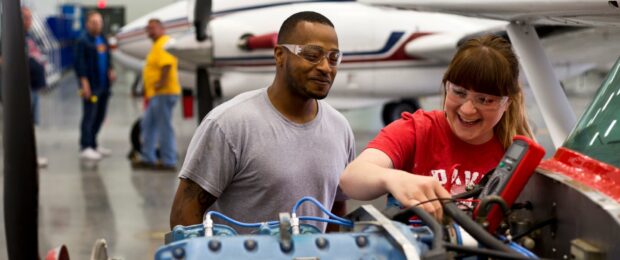HOME | ABOUT US | MEDIA KIT | CONTACT US | INQUIRE
HOME | ABOUT US | MEDIA KIT | CONTACT US | INQUIRE
White-collar jobs help elevate the average working wage in Kansas, but make no mistake: This state is a manufacturing monolith.

Yes, Kansas has a diverse economy, but when it comes to the leading industries in the state, some sectors are considerably more equal than others.
And that starts with manufacturing. If you look at the state’s GDP overall—$162.2 billion in 2022—you’ll find that one dollar in seven was generated by the aviation and manufacturing sector. There’s a reason why Wichita is known as the Air Capital of the World—despite the upheavals in the lightplane sector over the past generation, through the consolidations and downturns, it is still the output king in the Sunflower State.
Production agriculture, telecommunications, and petroleum refining, in order, preceded hospitals and health care as the only other sectors to generate more than $10 billion each within that GDP total.
For all its importance as a manufacturing hub, Kansas turned on the jets over the past year. State officials put together incentive packages with a combined $1.5 billion to help lure massive new investments in electric-vehicle battery production (Johnson County), semiconductors (Sedgwick County), and devices to combat electromagnetic bursts (Coffey County). When those plants are up and running within a few years, the state will realize an increase of more than 7,000 jobs in advanced manufacturing.
Much of that lifting is being done in the service of transportation: Small aircraft in Wichita and passenger vehicles in Kansas City. Wichita, in fact, turns out more light planes than any other city on the planet. Kansas City, home to a General Motors assembly plant for passenger vehicles, also adds to the mix. On top of those are the hundreds of smaller contractors, with tens of thousands of employees, providing parts and partial assemblies for those large companies.
Manufacturing’s strength often comes as a surprise to those who think of the Kansas economy in terms of shimmering fields of wheat or endless expanses of cattle feedlots. To be sure, production agriculture and the protein-chain processing of beef, poultry, and cattle combined would surpass manufacturing with a total of $32 billion in GDP. But as a single category in the GDP matrix, manufacturing is at the peak.
That doesn’t mean manufacturing tops the employment ranks. Thanks to advances in manufacturing technologies, far fewer workers are needed today, and they can still easily surpass production levels from the era before the use of the semiconductor was widespread. The top six employment sectors, in fact, exclude manufacturing.
At the top of that heap is health care, with more than 208,000 in the employee ranks last year. Retail trade, management services, information, hospitality, and professional services rounded out the Top Five, which had combined employment of more than 725,000. In a state with 1.27 million people of working age, that’s dominance.
You have to get to No. 7 and 8 on the list of biggest employment sectors to see the blue-collar impact: Transportation and warehousing at No. 7, with 85,743 jobs statewide, just ahead of construction’s 83,278.